London Design Guide: Architectural Icons
Part 1 featuring the Barbican, Battersea Power Station, Tate Modern, and St. Pancras Station
You know that feeling when you walk into a space and something just clicks? Maybe it's the way light is streaming through the windows, how the proportions feel just right, or a thoughtful detail that makes you pause. Maybe you don't immediately realize what it is at all and that’s okay. Some places just make you want to linger, explore, and know more.
I've always been drawn to the small details that make spaces, objects, moments, interactions, and experiences special. I’m fascinated by the why and how.
Design is one area where this curiosity really comes alive for me. Who chose those materials and why? Where were they made and by whom? What do they feel like and how does that impact the overall feeling of the space? How was this sewn together? How was this object or building constructed? Tell me about your life and how that brought you to where you are today. What was this place before and oh, I wish I could time travel and experience its past life for myself.
This new series isn't about chasing the most Instagrammable places in London, though many of them are beautiful. It's about spaces that feel good to be in. Thoughtfully designed and curated, quietly inspiring, enveloping, thought-provoking. Places that draw you in and make you want to spend more time there.
I invite you to slow down with me here to notice London's design moments - both the famous landmarks and the subtle details that make up the design landscape of this city. In doing so, I hope these places spark ideas, offer comfort, and provide a fresh perspective on the spaces we move through every day.
Each post in this series will dive into a different theme - whether it’s striking architecture, beautifully-designed cafés, inspiring public spaces, neighborhood deep-dives, or the creative people and materials that bring these environments to life.
Today’s theme is architectural icons: landmarks you’ve likely seen or heard of, but that are worth revisiting with fresh eyes and diving in deeper. These places continue to shape London’s design identity and remind us why the city remains a global capital of creativity.
1. The Barbican
I've thought about dedicating an entire post to the Barbican as I'd love to do some in-depth reading to learn more about it. Is it the prettiest space in London? Subjectively, no. It was even voted London's ugliest building in 2003, and regularly ends up on similar lists - any quick Google search will show you that. But it has always intrigued me and I love visiting.

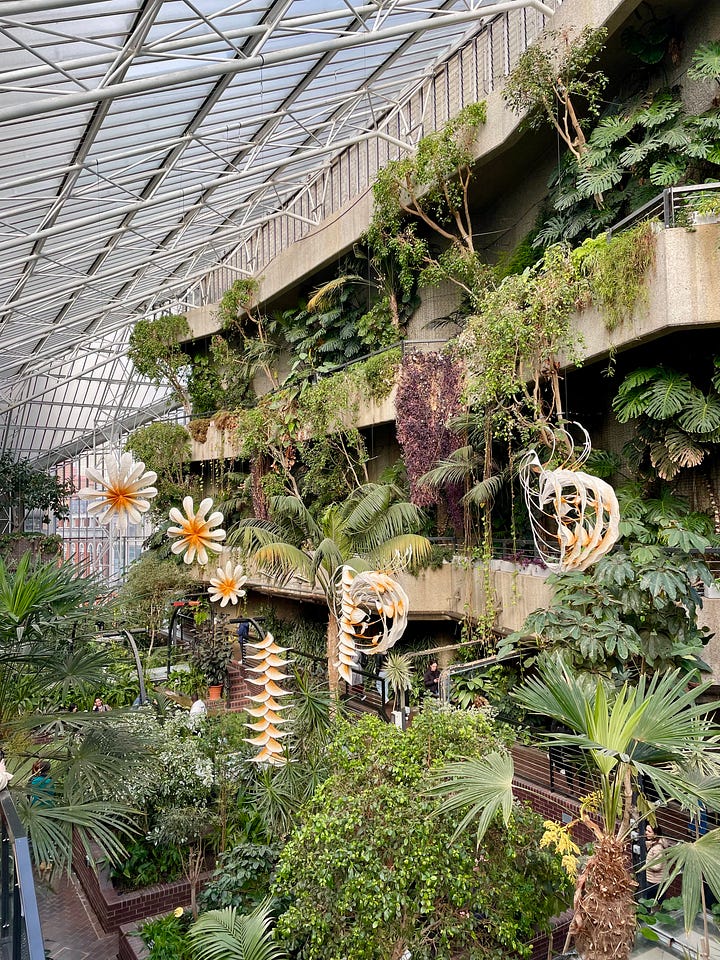
Despite its stark Brutalist architecture, there is still a feeling of warmth, which shouldn't come as a surprise given the carefully considered design by architects Chamberlin, Powell and Bon.
“…one of London’s most ambitious and unique architectural achievements: a city within a city that is raised above street level and draws on a rich palette of references, from ancient Roman fortresses and French Modernism to Mediterranean holidays and Scandinavian design” (Barbican Centre, barbican.org.uk, accessed 23/7/25).
The transformation of this site tells a fascinating story. Destroyed by the Blitz in 1941, the area was once a densely populated neighborhood called Cripplegate that “was the centre of the rag trade in London, home to many fabric merchants, tailoring and dressmaking businesses” (Building the Brutal: the Barbican Redevelopment, historicengland.org.uk, accessed 30/7/25). Tragically, the neighborhood was nearly fully destroyed when fires spread quickly after the Blitz due to the flammable nature of the fabrics and materials stored in the shops.
Construction of the Barbican began in 1965 and was a project that aimed to reimagine urban living. There you’ll find an art gallery, cinema, theater, residential flats, a school, cafe, library, conservatory, and more. You’ll also come across remnants of the original Roman London Wall and can step into one of the few remaining medieval churches in the City of London: St Giles without Cripplegate.
In 2001, the Barbican became Grade II listed, ensuring that it will be looked after and carefully considered from then on. It’s been on my list to take one of their architecture tours which you sign up for here if you’re also interested in learning more.
2. Battersea Power Station
We’re jumping from one grand, ‘beauty is in the eye of the beholder’ place to the next! Battersea Power Station was open from 1935-1983 and supplied a fifth of London’s power at the height of its production. It then sat unused, until redevelopment began in 2012, and was opened to the public in 2022.

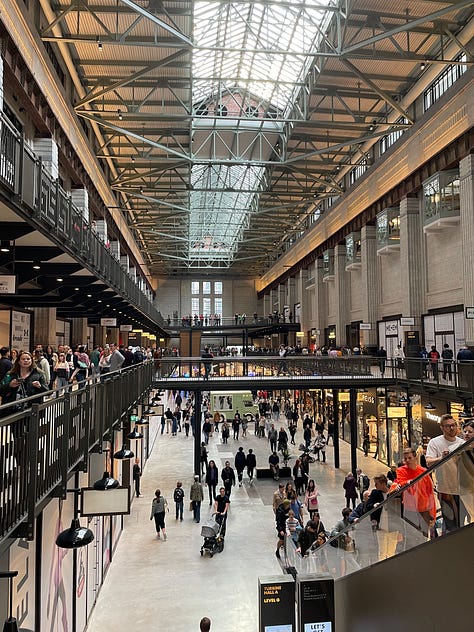

“The architectural practice, WilkinsonEyre, were appointed in 2013 for the transformation and refurbishment, with the designs consistent with Sir Giles Gilbert Scott’s original vision” (Battersea Power Station, batterseapowerstation.co.uk, accessed 23/7/25).
The Art-Deco and 1950s modernism interiors are just as awe-inspiring as the exterior. You’ll find exposed brick walls, industrial elements, and reimagined spaces like the cocktail bar, Control Room B, or Lift 109 where you can travel up one of the chimneys for a 360 degree view of London. No detail was left unconsidered in the redeveloped space. I particularly loved learning that two of the original brickmakers were even commissioned to make new, matching bricks for the renovation of the facade.
I encourage you to visit Battersea Power Station yourself if you haven't yet. It's hard not to feel something as you approach this London icon, recognizable by its four cylindrical chimneys and sitting majestically on the bank of the Thames. It's grand in every meaning of the word.
Yes, inside it's essentially a mall, but it's an exceptionally thoughtful one that honors the building's industrial heritage. The space invites you to stay awhile and appreciate both its impressive stature and rich history.
3. Tate Modern
Just like Battersea Power Station, the Tate Modern is a redeveloped power station and is an excellent example of adaptive reuse. The Bankside Power Station was in operation from 1962 until 1981 when it closed due to increases in oil prices. It was selected as the site of the new Tate Gallery of Modern Art in 1994 and officially opened its doors to the public as Tate Modern in May 2000.


Today, the Tate is composed of four major galleries: Tate Britain (London), Tate Modern (London), Tate Liverpool, and Tate St. Ives.
“Tate holds the national collection of British art from 1500 to the present day and international modern and contemporary art.
British art is represented by artists chosen for their contribution to its history and development, rather than their nationality alone. The collection continues to expand its holdings of modern and contemporary art from around the world” (Tate Modern, https://www.tate.org.uk/about-us/collection, accessed 29/7/25).
One thing I love about museums are the buildings they are housed in. While we (usually) go to museums for the collections within, it’s worth also taking the time to understand the building that was selected to hold those collections.
I love the Tate Modern’s location along the Thames and how its stark, industrial architecture contrasts with the elegant Baroque style of St. Paul’s Cathedral, which sits directly opposite and is accessible via the pedestrianized Millennium Bridge. The Turbine Hall is awe-inspiring in scale, a vast space used to display large-scale works that immediately immerse you. I appreciate how the restaurant offers spectacular views that invite you to linger. At this museum, you get a complete experience.
I’ll admit that I am someone who struggles to understand modern art. If you feel similarly, this video How the Tate Modern Changed the Art World. by The Design Concept provides an interesting overview and is well worth 3 minutes and 49 seconds of your time.
4. St. Pancras Station
St. Pancras is a Victorian Gothic stunner. Many Londoners find themselves under or quickly passing through King’s Cross St. Pancras as it’s a bustling train, underground and bus station. When I get a chance to see it above ground, I can’t help but marvel at its intricate red brick facade.

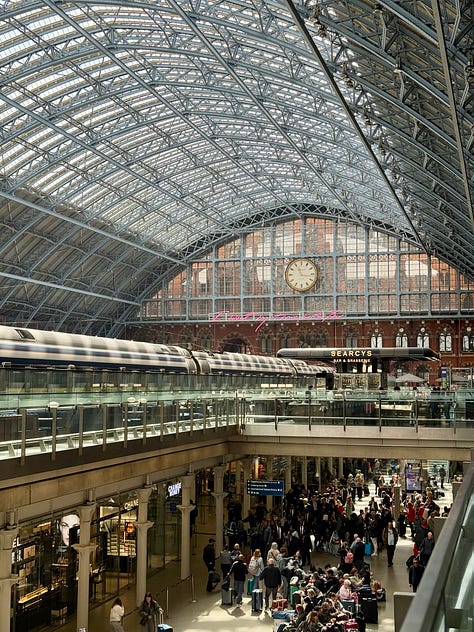
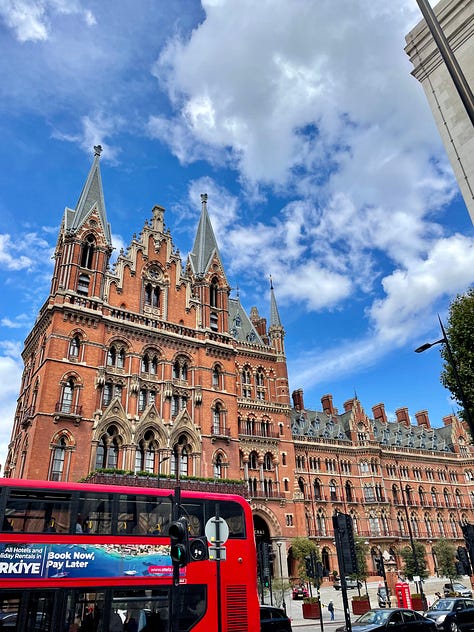
Originally opened in 1868 as the Midland Railway’s London terminus, St. Pancras comprised two parts: a train shed and what we know today as the St. Pancras Renaissance Hotel, formerly the Midland Grand. Sir George Gilbert Scott, who also designed the Red Telephone Box, the Tate Modern, and played a role in the design of the Battersea Power Station facade (and much more), was selected via an architectural competition.
His “design for St Pancras Station was a departure from the more utilitarian structures that characterised earlier railway architecture. Instead, he embraced a free Gothic style, combining functionality with aesthetic grandeur… with a red brick and terracotta façade that combined elements of Gothic architecture with Renaissance influences. The station’s clock tower, rising 280 feet above the ground, became a landmark in its own right, symbolizing the importance of rail travel in Victorian Britain” (St Pancras Station: A Gateway to the North, gilbertscott.org, accessed 29/7/25).
St. Pancras fell into decline after 1923 and was saved from demolition by “writer and broadcaster John Betjeman [who] spearheaded a campaign to save the station and hotel, and in November 1967 succeeded in getting the buildings declared Grade 1 listed days before demolition” (The Architecture the Railways Built, networkrail.co.uk, accessed 29/7/25).
I'm so glad this architectural gem is still around for us to enjoy - and that it's once again a prominent hub of train travel.
I think I snap a photo every single time I find myself under the glass roof of St. Pancras International, which today serves as the terminus of highspeed trains to Europe and around the UK. What particularly catches my eye - and the eyes of many others passing through - is the neon I Want My Time With You sign, by Tracey Emin RA, which “reminds travellers to stop and take a moment in one of the UK’s busiest railway stations” (Royal Academy, https://www.royalacademy.org.uk/exhibition/terrace-wires-tracey-emin).
When I think about these four architectural icons as a group, to me they represent London’s remarkable ability to be innovative while honoring its past. These places demonstrate that design isn’t just about how things look but also about how they feel and function. Each of these spaces was transformed through the creative vision of a few, their heritage reimagined through bold, forward-thinking design to be enjoyed by many. They make you want to linger, explore, and see London with fresh eyes.
Thank you for reading the first London Design Guide! I have so many other ideas for future design-oriented posts and would love to know what you thought of this one. Did you learn something? I did too - hence all the referencing! Do you have a greater appreciation for the spots highlighted here? Same.
I'd love to hear about the places that inspire or interest you. What other London spaces make you stop and take notice? Leave a comment below, I’d love to include some of your favorites in a future post.



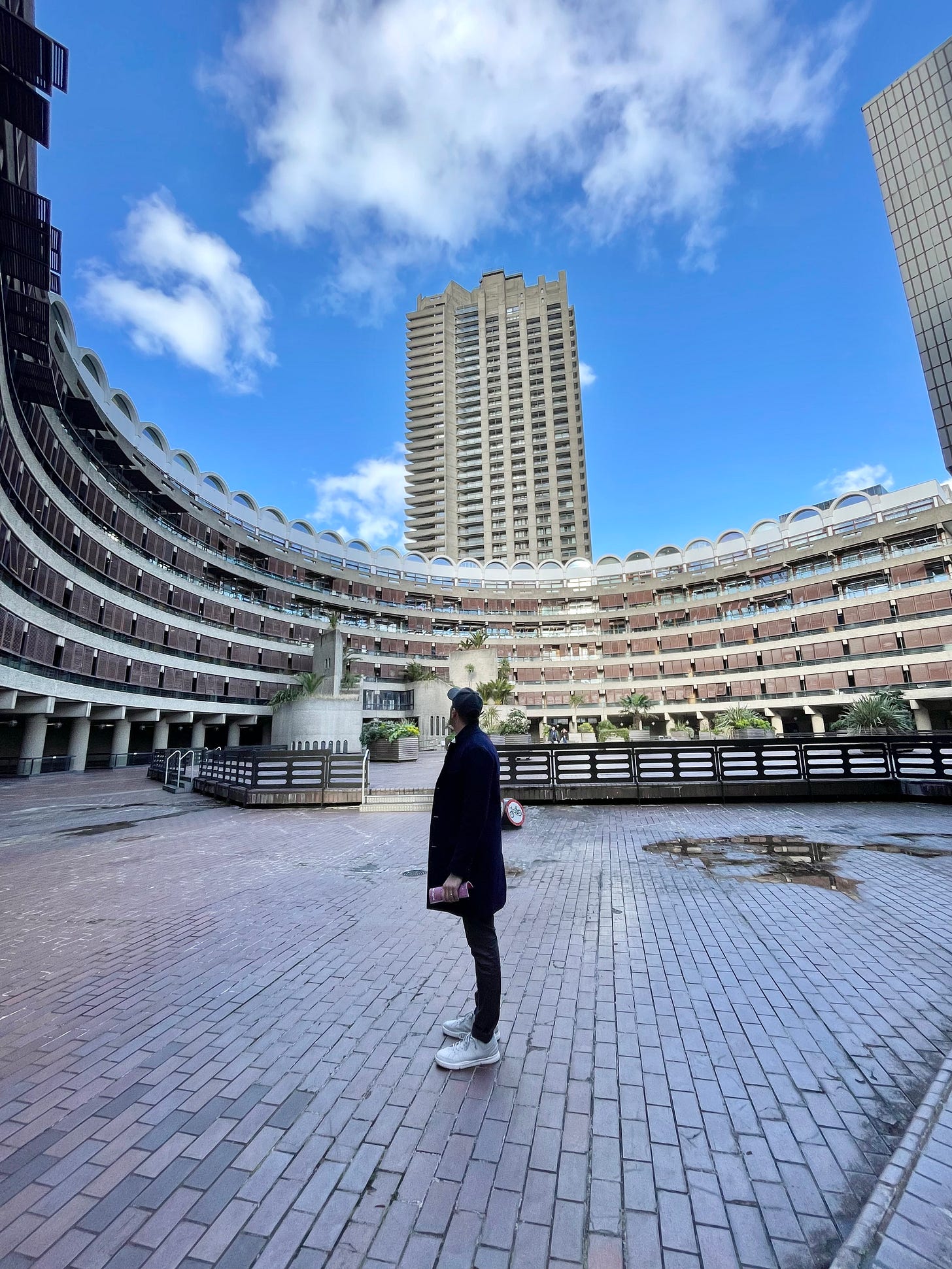
Anytime my eyes read the word "Barbican," my heart skips a beat. I adore everything about it and think it's one of the best examples of a multi-use structure that our world is lucky to have! Thank you for writing about it and these other wonderful buildings!!